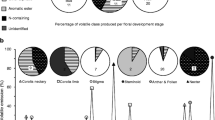Abstract
Floral scent was collected by headspace methods from intact flowers, petals, and stamens of four species ofPyrolaceae. The scent samples were analyzed by coupled gas chromatography-mass spectrometry (GC-MS). The floral scent inPyrola spp. is differentiated into a characteristic petal scent—phenyl propanoids and a characteristic stamen scent—methoxy benzenes. InMoneses the scent is characterized by isoprenoids and benzenoids, with a larger proportion of benzenoids in the stamens compared to the petals. Specific anther scents may promote foraging efficiency in buzz-pollinated species and enhance flower fidelity. Variation in floral scent composition is consistent with the taxonomic relationships among the genera and species examined.
Similar content being viewed by others
References
Andersen, J. F., 1987: Composition of the floral odor ofCucurbita maxima Duchesne (Cucurbitaceae). — J. Agric. Food Chem.35: 60–62.
Andrés, H., 1910:Pirolaceae. — Verh. Naturhist. Ver. Preuss. Rheinl. Westf. 100–149.
Aufsess, A. von, 1960: Geruchliche Nahorientierung der Biene bei entomophilen und ornithophilen Blüten. — Z. Vergl. Physiol.43: 469–498.
Beker, R., Dafni, A., Eisikowitch, D., Ravid, U., 1989: Volatiles of two chemotypes ofMajorana syriaca L. (Labiatae) as olfactory cues for the honeybee. — Oecologia79: 446–451.
Buchman, S. L., Cane, J. H., 1989: Bees assess pollen returns while sonicatingSolanum flowers. — Oecologia81: 289–294.
Campbell, C. S., Famous, N. C., Zuck, M. G., 1986: Pollination biology ofPrimula laurentiana (Primulaceae) in Maine. — Rhodora88: 253–260.
Dahl, Å. E., Wassgren, A.-B., Bergström, G., 1990: Floral scents inHypecoum sect.Hypecoum (Papaveraceae): chemical composition and relevance to taxonomy and mating system. — Biochem. Syst. Ecol.18: 157–168.
D'Arcy, W. G., D'Arcy, N. S., Keating, R. C., 1990: Scented anthers in theSolanaceae. — Rhodora92: 50–53.
Dobson, H. E. M., Bergström, J., Bergström, G., Groth, I., 1987: Pollen and flower volatiles in twoRosa species. — Phytochemistry26: 3171–3173.
—, 1990: Differences in fragrance chemistry between flower parts ofRosa rugosa Thunb. (Rosaceae). — Israel J. Bot.39: 143–156.
Fægri, K., van der Pijl, L., 1979: The principles of pollination ecology. 3rd edn. — Oxford: Pergamon Press.
Flath, R. A., Mon, T. R., Lorenz, C., Whitten, C. J., Mackley, J. W., 1983: Volatile components ofAcacia sp. blossoms. — J. Agric. Food Chem.31: 1167–1170.
von Frisch, K., 1919: Über den Geruchsinn der Biene und seine blütenbiologische Bedeutung. — Zool. Jahrb.37: 1–238.
Galen, C., Kevan, P. G., 1983: Bumblebee foraging and floral scent dimorphism:Bombus kirbyellus Curtis (Hymenoptera: Apidae) andPolemonium viscosum Nutt. (Polemoniaceae). — Canad. J. Zool.61: 1207–1213.
Grant, V., 1949: Pollination systems as isolating mechanisms in angiosperms. — Evolution3: 82–97.
Gregg, K. B., 1983: Variation in floral fragrances and morphology: incipient speciation inCycnoches? — Bot. Gaz.144: 566–576.
Groth, I., Bergström, G., Pellmyr, O., 1987: Floral fragrances inCimicifuga: Chemical polymorphism and incipient speciation inCimicifuga simplex. — Biochem. Syst. Ecol.15: 441–444.
Kevan, P. G., 1984: Pollination by animals and angiosperm biosystematics. —Grant, W. F., (Ed.): Plant biosystematics, pp. 271–292. — Toronto: Academic Press.
Knaben, G., 1943: Studier over norskePyrola-arter. — Bergens Mus. Årb., Naturvitensk. Ser.6: 2–19.
Krisa, B., 1971: Beitrag zur Taxonomie und Chorologie der GattungPyrola L. — Bot. Jahrb. Syst.90: 476–508.
Kugler, H., 1932: Blütenökologische Untersuchungen mit Hummeln. IV. Der Duft als chemischer Nahfaktor bei duftenden und “duftlosen” Blüten. — Planta16: 534–553.
Lex, T., 1954: Duftmale an Blüten. — Z. Vergl. Physiol.36: 212–234.
Nilsson, L. A., 1979: Anthecological studies on the Lady's SlipperCypripedium calceolus (Orchidaceae). — Bot. Not.132: 329–347.
Pellmyr, O., 1986: Three pollination morphs inCimicifuga simplex; incipient speciation due to inferiority in competition. — Oecologia68: 304–307.
—, 1984: Comparative analysis of the floral odors ofActaea spicata andA. erythrocarpa (Ranunculaceae). — Nova Acta Reg. Soc. Sci. Ups., Ser.V: C, 3: 157–160.
Porsch, O., 1954: Geschlechtgebundener Blütenduft. — Österr. Bot. Z.101: 359–372.
Proctor, M., Yeo, P., 1973: The pollination of flowers. — Glasgow: William Collins & Sons.
Stern, W. L., Curry, K. J., Whitten, W. M., 1986: Staining fragrance glands in orchid flowers. — Bull. Torrey Bot. Club113: 288–297.
Thien, L. B., Heimermann, W. H., Holman, R. T., 1975: Floral odors and quantitative taxonomy ofMagnolia andLiriodendron. — Taxon24: 557–568.
—, 1985: The pollination ofZygogynum (Winteraceae) by a moth,Sabatinca (Micropterigidae): an ancient association? — Science227: 540–543.
Tollsten, L., Berström, J., 1989: Variation and post-pollination changes in floral odours released byPlatanthera bifolia (Orchidaceae). — Nordic J. Bot.9: 359–362.
Vogel, S., 1963: Duftdrüsen im Dienste der Bestäubung: über Bau und Funktion der Osmophoren. — Akad. Wiss. Abh. Math.-Naturwiss. Kl. Mainz10: 601–723.
Williams, N. H., 1983: Floral fragrances as cues in animal behaviour. — InJones, C. E., Little, R. J., (Eds.): Handbook of experimental pollination biology, pp. 50–72. — New York: Van Nostrand Reinhold.
Author information
Authors and Affiliations
Rights and permissions
About this article
Cite this article
Knudsen, J.T., Tollsten, L. Floral scent and intrafloral scent differentiation inMoneses andPyrola (Pyrolaceae). Pl Syst Evol 177, 81–91 (1991). https://doi.org/10.1007/BF00937829
Received:
Accepted:
Issue Date:
DOI: https://doi.org/10.1007/BF00937829




